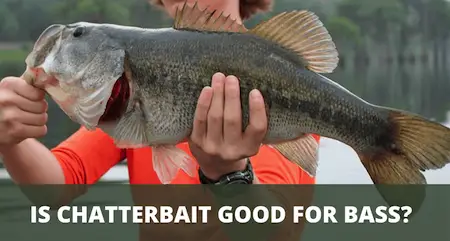How Good Is Chatterbait For Catching Bass? (3 Things You Should Know)
UPDATED 03 NOVEMBER 2023
by Robert Ceran
If you’re new to bass fishing, you’re probably confused by all the different types of lures that are available, and wondering which of these are best for bass fishing.
One lure type that gets a lot of attention is chatterbait. So is chatterbait good for bass fishing?
Here’s the quick answer:
Chatterbaits are among the most effective lures for bass fishing. The secret to their effectiveness lies in the action of the metal blade attached to their jig head, which creates a rapid wriggling vibration underwater that bass seem to find irresistible.

Now let’s look at this topic in more detail, and break it down into the following subtopics: how does a chatterbait work, how good is it for catching bass, and how can you use it for bass fishing?
If you’re interested in trying out this lure type, check out our reviw of the best rod for chatterbaits.
How does a chatterbait work?
A chatterbait is a type of bladed jig, which basically means it is a jig with a bent metal plate attached to the jig head. While there are other types of bladed jigs on the market, chatterbaits are the most popular and widely used among bass anglers.
When chatterbaits were originally introduced to the market, they were the only bladed jigs available, but since then others have been developed.
The bent metal blade of chatterbaits creates a rapid back and forth wriggling motion during retrieval, and this generates a characteristic vibration underwater that bass can sense through their lateral line organ.
The great thing about this is that the vibration is created simply by pulling the chatterbait through the water in a straight line, which makes it very easy to work this lure effectively.
In addition to the wriggling motion of the blade, most chatterbaits are fished with a trailer, which is a soft plastic bait that is rigged on to the hook (usually a swimbait or paddle tail).
So in addition to the vibration of the metal blade, the plastic tail of the trailer generates an additional wriggling motion in the water.
Are chatterbaits good for bass?
Absolutely – they are among the most effective bass lures available today. It seems that the rapid wriggling vibration they produce is very good at triggering bass to feed.
It’s not quite clear why this is, but one possibility is that it resembles the motion of a wounded baitfish.
As mentioned above, the vibration given off by a chatterbait swimming through the water is sensed by a bass lying in ambush, and causes it to come closer to investigate the lure.
When it gets close enough to see the lure, the combination of the wriggling movement of the blade and tail, plus its colors, often trigger the bass to lunge forward and grab the bait.
When chatterbaits were first introduced, they quickly became one of the most popular lures used by bass pro fishermen, and have helped many of them to win big tournaments.
One of the most well known among them is Brett Hite, who specializes almost entirely in using chatterbaits, which has earned him the nickname “The Chatterbait Whisperer.”
According to Brett, he has won more than a million dollars in tournament prize money by using chatterbaits, and he likes to tell the story of how he won two tournaments back to back with them, resulting in more than $250,000 in prize money within two weeks.
So based on this, it’s quite clear that chatterbait is great for catching bass. It combines the qualities of two other highly effective lures: the rapid wriggling motion of a rattle trap, as well as the ability to bounce off underwater objects like a square bill crankbait.
In addition, chatterbait can be skipped across the water surface similar to jigs, which means you can use it to reach spots underneath overhanging cover, such as docks and tree branches.
Taken together, these qualities not only make it one of the most effective and versatile bass lures on the market.
How do you catch bass on chatterbait?
As mentioned above, chatterbait is relatively easy to fish, since the lure does most of the work for you by vibrating underwater during retrieval.
So all you need to do is cast it close to promising ambush points where bass like to wait for prey. Examples of these would be laydowns (sunken trees), rocks, grass flats, and docks (for more details on the best locations to target check out our article: where to fish a chatterbait?).
There are some nuances to this that can help to improve your results. For example, you need to figure out how fast to retrieve the lure, and this can vary a lot from situation to situation. But in general, a relatively slow retrieval speed seems to work best.
Some anglers like to bounce chatterbait off objects such as grass, logs, or underwater rocks, and this can be a great tactic for triggering bass to bite. So just experiment with different retrieval techniques, and see which one works best for you.
